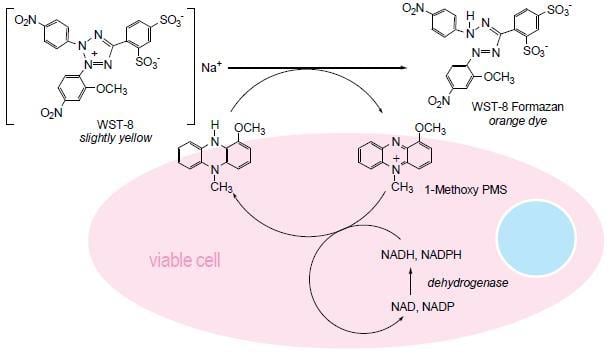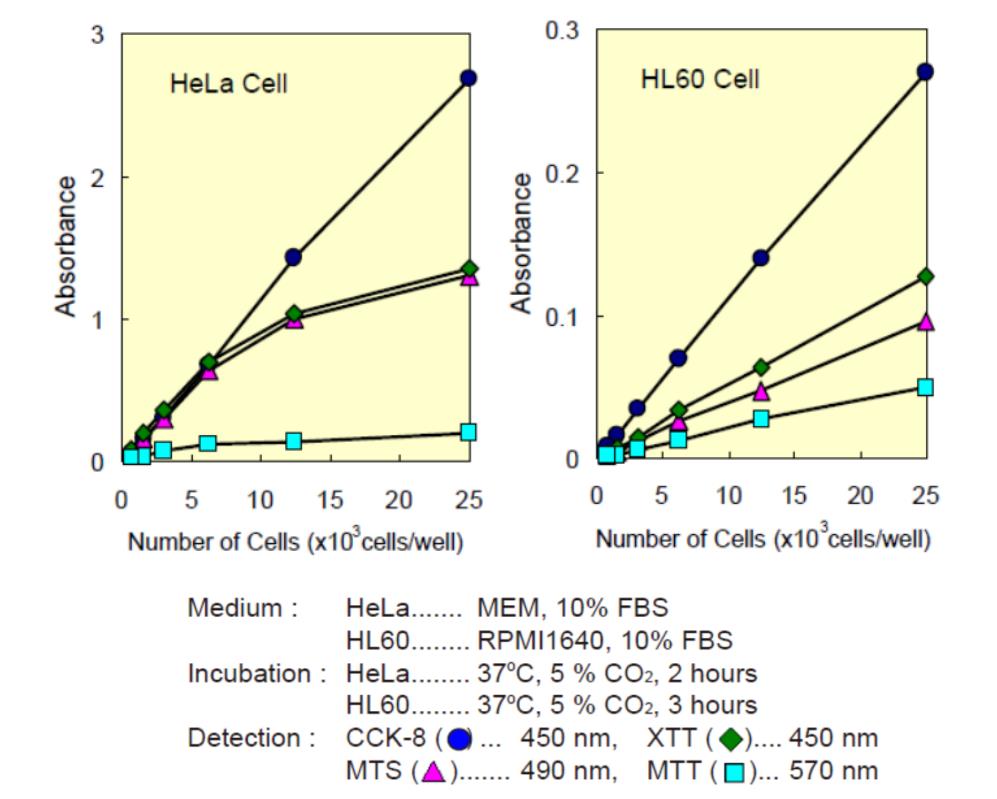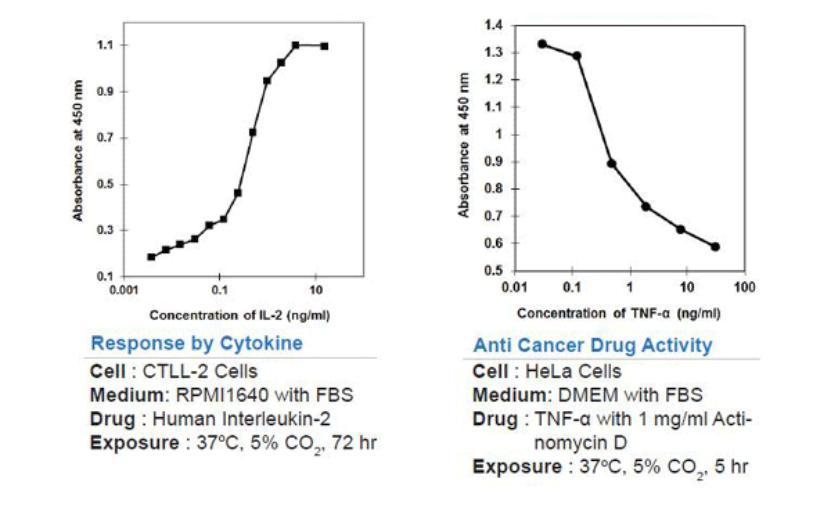Cell Counting Kit-8
Order Information
| Package | Catalog No. | Price(In USD) | Qty (Quantity) | Sum(In USD) |
|---|---|---|---|---|
| 100 T | R-CK100 | 50 | ||
| 500 T | R-CK500 | 200 | ||
| 1000 T | R-CK1000 | 360 | ||
| 3000 T | R-CK3000 | 1000 | ||
| Sub total: | ||||
| Shipping Cost: | 169.00 | |||
| Total: | ||||
Introduction to Cell Counting Kit-8
Cell Counting Kit-8 (CCK-8) allows very convenient assays by using highly water-soluble tetrazolium salt WST-8 (2-(2-methoxy-4-nitrophenyl)-3-(4-nitrophenyl)-5-(2,4-disulfophenyl)- 2H-tetrazolium, monosodium salt), which produces a water-soluble formazan dye upon bioreduction in the presence of an electron carrier, 1-Methoxy PMS.
While using, CCK-8 solution is added directly to the cells; no pre-mixing of components is required. WST-8 is bioreduced by cellular dehydrogenases to the orange formazan, which is soluble in tissue culture medium. The amount of produced formazan is directly proportional to the number of living cells. CCK-8 solution is very stable and has little cytotoxicity, thus longer incubations, such as 24 to 48 hours, are allowed.
Cell Counting Kit-8 allows sensitive colorimetric assays for determining the number of viable cells in the proliferation and cytotoxicity assays. The detection sensitivity is higher than any other tetrazolium salts such as MTT, XTT or MTS.
Properties
| Cell Counting Kit-8 | |
|---|---|
| Quantity/Unit | 1 bottle. |
| Form | Liquid. Light to deep red. |
| Storage | Stable for 2 years at -20 °C, 1 year at 4 °C and 6 months at room temperature with protection from light. To avoid repeated thawing and freezing, keep the kit at 4 °C for frequent use. |
Advantages
1. One-bottle, ready-to-use solution.
2. No organic solvents or isotopes required.
3. No harvesting, no washing and no solubilization steps.
4. More sensitive than MTT, XTT, MTS or WST-1.
Applications and Figures



Precautions
1. CCK-8 assay is based on the dehydrogenase activity detection in viable cells, thus conditions or chemicals that affect dehydrogenase activity may cause discrepancy between the actual viable cell number and the cell number determined by the CCK-8 kit.
2. WST-8 may react with reducing agents and generate formazan. Please check the background O.D. if reducing agents are used in cytotoxicity or cell proliferation assays.
3. Be careful not to introduce bubbles to the wells, since they interfere with the O.D. reading.
4. If sterilization is required, please filter the CCK-8 solution with a 0.2 μm filter.
5. The incubation time varies by the type and number of cells in a well. Generally, leukocytes give weak coloration, thus a long incubation time (up to 4 hours) or a large number of cells (~105 cells/well) may be necessary.
Measure and subtract the O.D. at 600 nm or higher from that of sample if there is a high turbidity in the cell suspension.
Technical Documents
1. For more information please refer to  Cell Counting Kit-8 User Manual
Cell Counting Kit-8 User Manual
Frequently Asked Questions(FAQs)
- 1. How many cells should there be in a well?
-
Answer
For adhesive cells, at least 1000 cells are required per well (100 μl medium) when using the kit's standard 96-well plate. For leukocytes, at least 2500 cells are necessary per well (100 μl medium) because of low sensitivity. The recommended maximum number of cells per well for the 96-well plate is 25000. If a 24-well or 6-well plate is used for this assay, please calculate the number of cells per well accordingly, and adjust the volume of the CCK-8 solution in a well to 10% of the total volume.
- 2. Does CCK-8 stain viable cells?
-
Answer
No, it does not stain viable cells because the water-soluble tetrazolium salt (WST-8) is used in the CCK-8 solution. The electron mediator, 1-Methoxy PMS, receives electrons from a viable cell and transfers the electron to WST-8 in the culture medium. Since its formazan dye is also highly water-soluble, CCK-8 cannot be utilized for cell staining purpose.
- 3. How stable is CCK-8?
-
Answer
CCK-8 is stable for 2 years at -20 °C, 1 year at 4 °C, and 3 months at room temperature. CCK-8 is stable over 2 days even at 60 °C as long as the CCK-8 solution keeps its original red color and does not turn orange.
- 4. Does phenol red affect the assay?
-
Answer
No. The absorption value of phenol red in a culture medium can be removed by subtracting the absorption value of a blank solution from the absorption value of each well. Therefore, a phenol red containing medium is usable for the CCK-8 assay.
- 5. Is CCK-8 toxic to cells?
-
Answer
The toxicity of CCK-8 is so low that, after performing the assay, the same cells can be used for other cell proliferation assays such as the crystal violet assay, neutral red assay or DNA fluorometric assay.
- 6. I do not have a 450 nm filter. What other filters can I use?
-
Answer
Although 450 nm filter gives the best sensitivity, you can use filters with the absorbance between 450 and 490 nm.
- 7. Can I use CCK-8 for 384-well plates?
-
Answer
CCK-8 can be used for 384-well plates. Please dilute the CCK-8 solution with PBS; the required volume of the CCK-8 solution is 5 μl per well for the 384-well plate.








